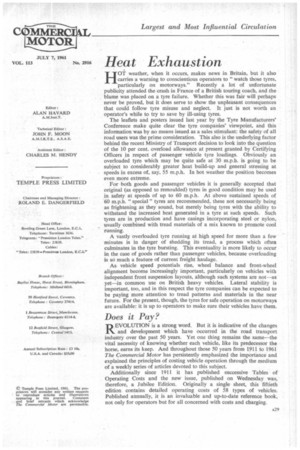Heat Exhaustion
Page 31

If you've noticed an error in this article please click here to report it so we can fix it.
HOT weather, when it occurs, makes news in Britain, but it also carries a warning to conscientious operators to "watch those tyres, particularly on motorways." Recently a lot of unfortunate publicity attended the crash in France of a British touring coach, and the blame was placed on a tyre failure. Whether this was fair will perhaps never be proved, but it does serve to show the unpleasant consequences that could follow tyre misuse and neglect. It just is not worth an operator's while to try to save by ill-using tyres.
The leaflets and posters issued last year by the Tyre Manufacturers' Conference make quite clear the tyre companies' viewpoint, and this information was by no means issued as a sales stimulant: the safety of all road users was the prime consideration. This also is the underlying factor behind the recent Ministry of Transport decision to look into the question of the 10 per cent. overload allowance at present granted by Certifying Officers in respect of passenger vehicle tyre loadings. Obviously an overloaded tyre which may be quite safe at 30 m.p.h. is going to be subject to considerably greater heat build-up and general stressing at speeds in excess of, say, 55 m.p.h. In hot weather the position becomes even more extreme.
For both goods and passenger vehicles it is generally accepted that original (as opposed to remoulded) tyres in good condition may be used in safety at speeds of up to 60 m.p.h. At above sustained speeds of 60 m.p.h. " special " tyres are recommended, these not necessarily being as frightening as they sound, but merely being tyres with the ability to withstand the increased heat generated in a tyre at such speeds. Such tyres are in production and have casings incorporating steel or nylon, usually combined with tread materials of a mix known to promote cool running.
A vastly overloaded tyre running at high speed for more than a few minutes is in danger of shedding its tread, a process which often culminates in the tyre bursting. This eventuality is more likely to occur in the case of goods rather than passenger vehicles, because overloading is so much a feature of current freight haulage.
As vehicle speed potentials rise, wheel balance and front-wheel alignment become increasingly important, particularly on vehicles with independent front suspension layouts, although such systems are not—as yet—in common use on British heavy vehicles. Lateral stability is important, too, and in this respect the tyre companies can be expected to be paying more attention to tread patterns and materials in the near future. For the present, though, the tyres for safe operation on motorways are available: it is up to operators to make sure their vehicles have them.
Does it Pay?
REVOLUTION is a strong word. But it is indicative of the changes and development which have occurred in the road transport industry over the past 50 years. Yet one thing remains the same—the vital necessity of knowing whether each vehicle, like its predecessor the horse, earns its keep. And throughout those 50 years from 1911 to 1961 The Commercial Motor has persistently emphasized the importance and explained the principles of costing vehicle operation through the medium of a weekly series of articles devoted to this subject.
Additionally since 1911 it has published successive Tables of Operating Costs and the new issue, published on Wednesday was, therefore, a Jubilee Edition. Originally a single sheet, this fiftieth edition contains detailed operating costs of 58 types of vehicles. Published annually, it is an invaluable and up-to-date reference book, not only for operators but for all concerned with costs and charging.




















































































































